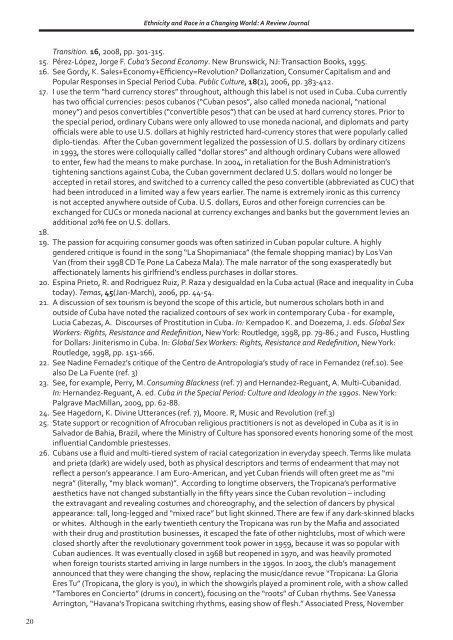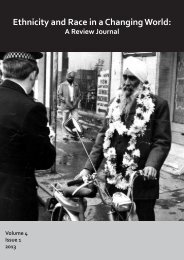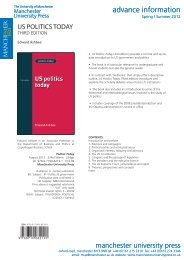<strong>Ethnicity</strong> <strong>and</strong> <strong>Race</strong> <strong>in</strong> a Chang<strong>in</strong>g <strong>World</strong>: A Review JournalTransition. 16, 2008, pp. 301-315.15. Pérez-López, Jorge F. Cuba’s Second Economy. New Brunswick, NJ: Transaction Books, 1995.16. See Gordy, K. Sales+Economy+Efficiency=Revolution? Dollarization, Consumer Capitalism <strong>and</strong> <strong>and</strong>Popular Responses <strong>in</strong> Special Period Cuba. Public Culture, 18(2), 2006, pp. 383-412.17. I use the term “hard currency stores” throughout, although this label is not used <strong>in</strong> Cuba. Cuba currentlyhas two official currencies: pesos cubanos (“Cuban pesos”, also called moneda nacional, “nationalmoney”) <strong>and</strong> pesos convertibles (“convertible pesos”) that can be used at hard currency stores. Prior tothe special period, ord<strong>in</strong>ary Cubans were only allowed to use moneda nacional, <strong>and</strong> diplomats <strong>and</strong> partyofficials were able to use U.S. dollars at highly restricted hard-currency stores that were popularly calleddiplo-tiendas. After the Cuban government legalized the possession of U.S. dollars by ord<strong>in</strong>ary citizens<strong>in</strong> 1993, the stores were colloquially called “dollar stores” <strong>and</strong> although ord<strong>in</strong>ary Cubans were allowedto enter, few had the means to make purchase. In 2004, <strong>in</strong> retaliation for the Bush Adm<strong>in</strong>istration’stighten<strong>in</strong>g sanctions aga<strong>in</strong>st Cuba, the Cuban government declared U.S. dollars would no longer beaccepted <strong>in</strong> retail stores, <strong>and</strong> switched to a currency called the peso convertible (abbreviated as CUC) thathad been <strong>in</strong>troduced <strong>in</strong> a limited way a few years earlier. The name is extremely ironic as this currencyis not accepted anywhere outside of Cuba. U.S. dollars, Euros <strong>and</strong> other foreign currencies can beexchanged for CUCs or moneda nacional at currency exchanges <strong>and</strong> banks but the government levies anadditional 20% fee on U.S. dollars.18.19. The passion for acquir<strong>in</strong>g consumer goods was often satirized <strong>in</strong> Cuban popular culture. A highlygendered critique is found <strong>in</strong> the song “La Shopimaniaca” (the female shopp<strong>in</strong>g maniac) by Los VanVan (from their 1998 CD Te Pone La Cabeza Mala). The male narrator of the song exasperatedly butaffectionately laments his girlfriend’s endless purchases <strong>in</strong> dollar stores.20. Esp<strong>in</strong>a Prieto, R. <strong>and</strong> Rodriguez Ruiz, P. Raza y desigualdad en la Cuba actual (<strong>Race</strong> <strong>and</strong> <strong>in</strong>equality <strong>in</strong> Cubatoday). Temas, 45(Jan-March), 2006, pp. 44-54.21. A discussion of sex tourism is beyond the scope of this article, but numerous scholars both <strong>in</strong> <strong>and</strong>outside of Cuba have noted the racialized contours of sex work <strong>in</strong> contemporary Cuba - for example,Lucia Cabezas, A. Discourses of Prostitution <strong>in</strong> Cuba. In: Kempadoo K. <strong>and</strong> Doezema, J. eds. Global SexWorkers: Rights, Resistance <strong>and</strong> Redef<strong>in</strong>ition, New York: Routledge, 1998, pp. 79-86.; <strong>and</strong> Fusco, Hustl<strong>in</strong>gfor Dollars: J<strong>in</strong>iterismo <strong>in</strong> Cuba. In: Global Sex Workers: Rights, Resistance <strong>and</strong> Redef<strong>in</strong>ition, New York:Routledge, 1998, pp. 151-166.22. See Nad<strong>in</strong>e Fernadez’s critique of the Centro de Antropologia’s study of race <strong>in</strong> Fern<strong>and</strong>ez (ref.10). Seealso De La Fuente (ref. 3)23. See, for example, Perry, M. Consum<strong>in</strong>g Blackness (ref. 7) <strong>and</strong> Hern<strong>and</strong>ez-Reguant, A. Multi-Cubanidad.In: Hern<strong>and</strong>ez-Reguant, A. ed. Cuba <strong>in</strong> the Special Period: Culture <strong>and</strong> Ideology <strong>in</strong> the 1990s. New York:Palgrave MacMillan, 2009, pp. 62-88.24. See Hagedorn, K. Div<strong>in</strong>e Utterances (ref. 7), Moore. R, Music <strong>and</strong> Revolution (ref.3)25. State support or recognition of Afrocuban religious practitioners is not as developed <strong>in</strong> Cuba as it is <strong>in</strong>Salvador de Bahia, Brazil, where the M<strong>in</strong>istry of Culture has sponsored events honor<strong>in</strong>g some of the most<strong>in</strong>fluential C<strong>and</strong>omble priestesses.26. Cubans use a fluid <strong>and</strong> multi-tiered system of racial categorization <strong>in</strong> everyday speech. Terms like mulata<strong>and</strong> prieta (dark) are widely used, both as physical descriptors <strong>and</strong> terms of endearment that may notreflect a person’s appearance. I am Euro-American, <strong>and</strong> yet Cuban friends will often greet me as “m<strong>in</strong>egra” (literally, “my black woman)”. Accord<strong>in</strong>g to longtime observers, the Tropicana’s performativeaesthetics have not changed substantially <strong>in</strong> the fifty years s<strong>in</strong>ce the Cuban revolution – <strong>in</strong>clud<strong>in</strong>gthe extravagant <strong>and</strong> reveal<strong>in</strong>g costumes <strong>and</strong> choreography, <strong>and</strong> the selection of dancers by physicalappearance: tall, long-legged <strong>and</strong> “mixed race” but light sk<strong>in</strong>ned. There are few if any dark-sk<strong>in</strong>ned blacksor whites. Although <strong>in</strong> the early twentieth century the Tropicana was run by the Mafia <strong>and</strong> associatedwith their drug <strong>and</strong> prostitution bus<strong>in</strong>esses, it escaped the fate of other nightclubs, most of which wereclosed shortly after the revolutionary government took power <strong>in</strong> 1959, because it was so popular withCuban audiences. It was eventually closed <strong>in</strong> 1968 but reopened <strong>in</strong> 1970, <strong>and</strong> was heavily promotedwhen foreign tourists started arriv<strong>in</strong>g <strong>in</strong> large numbers <strong>in</strong> the 1990s. In 2003, the club’s managementannounced that they were chang<strong>in</strong>g the show, replac<strong>in</strong>g the music/dance revue “Tropicana: La GloriaEres Tu” (Tropicana, the glory is you), <strong>in</strong> which the showgirls played a prom<strong>in</strong>ent role, with a show called“Tambores en Concierto” (drums <strong>in</strong> concert), focus<strong>in</strong>g on the “roots” of Cuban rhythms. See VanessaArr<strong>in</strong>gton, “Havana's Tropicana switch<strong>in</strong>g rhythms, eas<strong>in</strong>g show of flesh.” Associated Press, November20
<strong>Ethnicity</strong> <strong>and</strong> <strong>Race</strong> <strong>in</strong> a Chang<strong>in</strong>g <strong>World</strong>: A Review Journal2, 2004. Elizabeth Ruf Maldonado, who conducted research at the Tropicana <strong>in</strong> the early to mid 1990s,argues that the Tropicana’s popularity with Cubans is due <strong>in</strong> part to the fact that the mulata embodiesthe national ideal of racial mix<strong>in</strong>g or mestizaje <strong>and</strong> is thus a patriotic symbol, not only an object of desire.See MaldonRuf, E. Que l<strong>in</strong>da es Cuba!: Issues of Gender, Color, <strong>and</strong> Nationalism <strong>in</strong> Cuba's TropicanaNightclub Performance. TDR, 41(1), 1997, pp. 86-105. Kaifa Rol<strong>and</strong> notes that female dancers tend tobe “mulaticized” by headdresses <strong>and</strong> hairstyles that obscure their race. See Rol<strong>and</strong>, K. Tourism <strong>and</strong> theNegrificacion of Cuban Identity. Transform<strong>in</strong>g Anthropology, 14(2): 151-162, 2006 p. 158-9.27. The correct term<strong>in</strong>ology to describe African-orig<strong>in</strong> or black-identified cultural practices <strong>in</strong> Cuba is thesubject of some debate. The pioneer<strong>in</strong>g (<strong>and</strong> often problematic) scholar Fern<strong>and</strong>o Ortiz used the term“Afrocuban religions,” <strong>and</strong> other early twentieth century writers often referred to “Afrocuban cults”.In recent years scholars <strong>and</strong> museum <strong>and</strong> heritage professionals have adopted the term, “religionsof African orig<strong>in</strong>” (although the word “cult” still appears from time to time). For a further discussionof this evolution, see Pedroso, Louis A. Las exposiciones de ‘cultos afrocubanos’ y la necesidad de sureconceptualización. Catauro: Revista Cubana De Antropología 3(5), pp. 126–141.28. I use “festive ethnicity” here as a shorth<strong>and</strong> expression for the ways <strong>in</strong> which both state <strong>and</strong> non-stateactors use performances, festivals, exhibitions <strong>and</strong> other visual <strong>and</strong> performative means to forge orre<strong>in</strong>force ethnic, cultural, national, racial <strong>and</strong> other identities. The upbeat, celebratory tone of thenarratives <strong>and</strong> performances effectively pre-empts or precludes any critical <strong>in</strong>terrogation, <strong>and</strong> oftenserves the purpose of mask<strong>in</strong>g persistent <strong>in</strong>equalities with a veneer of harmonious <strong>in</strong>clusivity. In theh<strong>and</strong>s of state <strong>in</strong>stitutions, festive ethnicity often undergirds specific nationalist projects, <strong>in</strong>clud<strong>in</strong>gofficial multiculturalism. On the other h<strong>and</strong>, ethnic <strong>and</strong> racial m<strong>in</strong>orities can use festive ethnicity tochallenge exclusionary practices <strong>and</strong> stake their own claims. There are many recent articles <strong>and</strong> a fewbooks that provide nuanced analyses of these phenomena. David Guss’ The Festive State: <strong>Race</strong>, <strong>Ethnicity</strong><strong>and</strong> Nationalism as Cultural Performance exam<strong>in</strong>es festivals <strong>and</strong> performance <strong>in</strong> Venezuela - see Guss,D. The Festive State: <strong>Race</strong>, <strong>Ethnicity</strong> <strong>and</strong> Nationalism as Cultural Performance. Berkeley: University ofCalifornia Press, 2000. Several of the chapters <strong>in</strong> Lisa Maya Knauer <strong>and</strong> Daniel Walkowitz, eds. ContestedHistories <strong>in</strong> Public Space: Memory, <strong>Race</strong> <strong>and</strong> Nation explore these concerns <strong>in</strong> a variety of case studies -see Maya Knauer, L. <strong>and</strong> Walkowitz, D. eds. Contested Histories <strong>in</strong> Public Space: Memory, <strong>Race</strong> <strong>and</strong> Nation.Duke University Press, 2009 - for example, Amar, P. Sav<strong>in</strong>g Rio's "Cradle of Samba": Outlaw Upris<strong>in</strong>gs,Racial Tourism, <strong>and</strong> the Progressive State <strong>in</strong> Brazil. pp. 249-279; <strong>and</strong> Poole, D. Affective Dist<strong>in</strong>ctions:<strong>Race</strong> <strong>and</strong> Place <strong>in</strong> Oaxaca. pp. 197-227. See also Kuutma, K. Festival as communicative performance <strong>and</strong>celebration of ethnicity. Folklore: Electronic Journal of Folklore, 7, [onl<strong>in</strong>e] pp. 79-86. 1998. (Retrieved July12, 2009). (Url: http: www.ceeol.com.); <strong>and</strong> Ste<strong>in</strong>er, C. The Invisible Face: Masks, <strong>Ethnicity</strong> <strong>and</strong> the State<strong>in</strong> Cote d’Ivoire. In: Roy Richard Gr<strong>in</strong>ker <strong>and</strong> Christopher Ste<strong>in</strong>er (eds), Perspectives on Africa: A Reader InCulture, History <strong>and</strong> Representation. Oxford: Blackwell Press, 1997 pp. 671-679.29. My translation. The orig<strong>in</strong>al statement by Martí is “No hay odio de razas, porque no hay razas. .... Cubanoes mas que blanco, mas que mulato, mas que negro…”30. “La Vida es un Carnaval” (words <strong>and</strong> music by Victor Daniel ). The song appears on at least two CDsby Delgado that were released <strong>in</strong> 2000: La Primera Noche (Caribe Productions), <strong>and</strong> La Formula (AhiNama Music). Delgado’s music video of the song features hundreds of Cubans (mostly young women <strong>in</strong>skimpy cloth<strong>in</strong>g) gyrat<strong>in</strong>g <strong>and</strong> wav<strong>in</strong>g their arms as they s<strong>in</strong>g <strong>and</strong> dance to the chorus. The song was alsorecorded by Celia Cruz, <strong>and</strong> numerous other performers.31. Harvey, Da<strong>in</strong>a C. (Re)Creat<strong>in</strong>g Culture Through Tourism: Black Heritage Space <strong>in</strong> New Jersey. In: MelanieSmith, Melanie K. ed. Tourism, Culture <strong>and</strong> Regeneration. Oxford: Oxford University Press, 2007. pp. 59-68.32. Efforts to “preserve”, renovate <strong>and</strong>/or restore urban sites such as New York City’s Union Square Parkhave often been criticized for putt<strong>in</strong>g the <strong>in</strong>terests of real estate developers <strong>and</strong> upper-middle classprofessionals over those of local residents. Aesthetic <strong>and</strong> design choices – reflect<strong>in</strong>g elite visions <strong>and</strong>often enhanc<strong>in</strong>g the ability to secure <strong>and</strong> survey public spaces – have also come under critical scrut<strong>in</strong>y.See Deutsche, R. Evictions: Art <strong>and</strong> Spatial Politics. Cambridge: MIT Press, 1996.; Page M. <strong>and</strong> Mason, R.Giv<strong>in</strong>g Preservation a History: Histories of Historic Preservation <strong>in</strong> the United States. New York <strong>and</strong> London:Routledge, 2004; <strong>and</strong> Herzfeld, M. A Place <strong>in</strong> History: Social <strong>and</strong> Monumental Time <strong>in</strong> a Cretan Town.Pr<strong>in</strong>cetown: Pr<strong>in</strong>cetown University Place, 1991.33. See Michael Herzfeld (ref. 32)34. In Spanish, the Ofic<strong>in</strong>a del Historiador de la Ciudad de la Habana (OHCH).35. For a more thorough discussion of the role of the OHCH <strong>in</strong> the reconstruction of Old Havana, <strong>and</strong> thepowers of the agency, see Hill, M. Globaliz<strong>in</strong>g Havana: <strong>World</strong> Heritage <strong>and</strong> Urban Redevelopment <strong>in</strong> Late21






